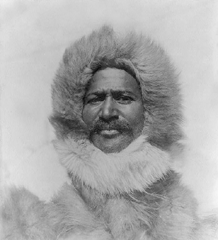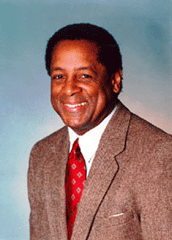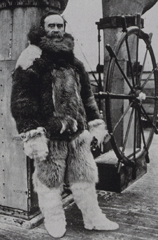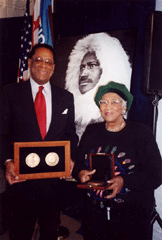True Stories from the North Pole
Air Date: Week of April 17, 2009

Matthew Henson was an African-American man largely overlooked for his crucial role in exploring the North Pole. (Courtesy of the Library of Congress)
This month marks 100 years since Robert Peary became the first person to reach the North Pole...or was he? Host Jeff Young talks with Harvard Professor S. Alan Counter who's investigated Peary's journey. Counter says the trip to the pole is just the tip of the iceberg. The rest of Peary's story includes an overlooked African-American explorer, who played a crucial role on the journey and Inuit children the explorers fathered and then left behind.
Transcript
YOUNG: One hundred years ago explorer Robert Peary sent a telegram from the Arctic Circle that read, "Stars and stripes nailed to the North Pole."

Dr. S. Allen Counter is a Harvard medical school professor, author and adventurer. (Courtesy of S. Allen Counter)
But, turns out Peary’s version of the story is, well, just the tip of the iceberg. Harvard professor and explorer Dr. Allen Counter has devoted decades to filling in the missing chapters. And what Counter’s uncovered is a far more complex picture. For starters, Counter says Peary’s success largely depended on an African American man named Matthew Henson, a crucial member of the polar expedition.
COUNTER: Reaching the North Pole at that time was tantamount to reaching the moon in our lifetimes. No one knew what to expect at the top of the earth, but Peary was a determined man, and he wanted to be the first human being to stand at the top of the earth. You know, later these things came out. But Henson was a man, an African American, who at that time was essentially disenfranchised like most African Americans, and when Peary tried to give an explanation of why he hired Henson, he often said that this was a very intelligent negro man, he was of greater intelligence than most I’ve met, etcetera, and I found in him the abilities that enable him to assist me to get to the pole. Now Henson with equal pride said on the other hand, I met this man Peary, a white man who had the traits and characteristics that made me want to desire to give him my services. So there was pride on both sides.
YOUNG: Did Henson get proper credit or recognition for his contributions?
COUNTER: Well, you ask an interesting and almost I’m sure rhetorical question – it is obvious that none of the people of color, the Inuit people who helped get both of them there nor Henson received any credit. In fact, one general, General Greely, said well, he hasn’t sure Peary made it to the North Pole because all he had for proof was an ignorant Negro and some ignorant Inuit people.

Robert Peary is credited as the first person to set foot on the North Pole (Courtesy of NOAA).
COUNTER: Exactly, they were not – they were called non-credible witnesses. At the same time there was a congressman, I don’t recall his name right away, who wanted to recommend medals for the other men, but he stopped short of doing that because he was afraid he would have to recommend Henson for a medal and he quote “did not want to introduce the name a of a negro on the House floor.” I wonder how we would feel now to see that not only the House floor, but the White House [laughing] has a person of color. So these are the kinds of things that are documented that they faced. Also, the National Geographic gave all sorts of credits and awards and accolades to Peary and totally ignored Henson.
YOUNG: Wow, its just amazing the way that race colored – pardon the pun – the whole enterprise.
COUNTER: Yes. It played a role in every step along the way. And according to the Inuit people, Henson fell asleep on the last part of the dash and Peary tried to wake ‘em up and get them to go ahead without Henson. [laughing] And they wouldn’t do it because they were close to Henson. Henson spoke the language like a native and he persuaded them to go and help them. And so, when they made the final dash Henson took off and was ahead of Peary. And apparently there was an argument. In the 1910 Boston Herald there’s an interview with Henson where he said “Mr. Peary didn’t speak to me all the way back” [laugh] “to the ship.” And when Peary finally arrived he said, “I thought I told you to halt. I gave you an order to halt short of the pole.” And Henson said, “well, I just dashed forward and everything beyond us now is south so we’re both here” or something to that effect. But I’ll bet you Henson probably said to him “Now when you get back to America, you’ll be the all-powerful white leader and you’ll get all the credit. But I want you to know that on this day a colored man from Washington D.C. was the first human being to stand on the pole with these four Inuit men.”
YOUNG: One of the missing chapters if you will here has to do with Henson. But there’s another, and that has to do with the fact that they left behind more than just a flag while they were up there, didn’t they?
COUNTER: [Laughs] Well that’s one way to look at it. Some periods of time during the exploration they were isolated in Greenland, in Northern Canada for up to four years at a time. And they took on virtual Inuit wives. I mean in Peary’s case, he was married, but he had an Inuit wife there as well. And it turns out that Peary fathered two children with her. And Matthew Henson who was not married at the time, Peary’s assistant, had a wife in A La Casina. And she bore him a child. And that child’s name was Anaukaq.

Matthew Henson was an African-American man largely overlooked for his crucial role in exploring the North Pole. (Courtesy of the Library of Congress)
YOUNG: Well, you clearly became very close to these folks and you made a pretty big promise for a special event to mark this anniversary this year. Tell me about that.
COUNTER: Well, you know, when you make promises you have to be careful. Its something I’ve learned with my children.
[LAUGHING]
COUNTER: When you say you’re gonna do something, people expect you to do it. And we started talking with the older sons whom I really came to adore and they were talking about the North Pole and how they would like to go and so forth. But they said, you know, we’re old and we’re going to die soon. And we know that. They were both about 80 at the time. And they said maybe our children will go. And I said I’ll give you my word that when the anniversary of the North Pole discovery comes around in 2009, I’m gonna go there and take children from both sides of the family, the Inuit Peary family and the Inuit Henson.
YOUNG: Go there – you mean to the North Pole.
COUNTER: To the North Pole. I’m going to….
[LAUGHING]
COUNTER: I mean I had no idea how to actually do this. So, you know, you make these promises twenty years ahead. And all of a sudden the time comes around and people are saying basically, what are you going to do. And so I made every effort. I contacted the Air Force and we discussed the prospect. They were very helpful. It was decided that we would take a flight on a C-130, but unfortunately just as I was so enthusiastic about this – I’d notified the family, we’d asked them to select the different family members who would go with us, we were gonna lay a wreath, we were gonna take a time capsule and take a commemorative capsule there and bring it back for young people to learn more about the Artic. Just as we decided to do that, we got the bad news that well, we’ve looked at this and its unlikely we can do this exercise because the ice pack over the ice is so weak, we could not tolerate landing there. And I had heard too that there’d been difficulty with other planes. In fact, I don’t have concrete evidence, but I’ve been told of two instances where planes sank after landing there. So we couldn’t put anybody’s lives at risk. So there I was without a flight. I was able to get the U.S. Navy submarine with the help of Admiral Melvin G. Williams, Jr. were able to get the commemorative case containing memorabilia from Henson and Peary to the North Pole. And we’re very proud of that.

Dr. S. Allen Counter presents the National Geographic Hubbard Gold Medal to Mrs. Audrey Mebane, great-niece of North Pole explorer Matthew Henson (center photo), who earned the award posthumously (Courtesy of S. Allen Counter).
COUNTER: When you start an initiative like this, you cannot predict where it’s going to go, what’s going to happen. Who would have thought that you’d meet a man who just becomes a part of your life. And Afro-Inuit or an Afro-Eskimo who tells you what it means for him to just meet a family member. And it touched my heart very deeply. And become more like family now, not just friends or acquaintances. When they were here in 1987, one of those sons had a pregnant wife. And he said, you know, I’m looking forward to my child and we don’t know what to name him. My mother said to Vittus the grandson of Matthew Henson, she said name him Allen.
[LAUGHING]
COUNTER: And just dropped it like that. So when I got back to Greenland, I must tell you, I was absolutely, just pleasantly shocked to see a six foot five Inuit young man 20 years old, just turning twenty one now named Allen.
[LAUGHING]
COUNTER Allen Henson. I mean it just touched my heart deeply. So not only am I a member of the family, but there’s a young man there named for me and I was just so touched. So, again, that’s why you do it – it’s a human thing. I had no motives other than that from the outset to now.
YOUNG: This is such an amazing story. And it’s on top of what was already and amazing story. Thank you very much for your time. I appreciate it very much.
COUNTER: Thank you very much for having me.
YOUNG: Dr. Allen Counter is a neurology professor at Harvard University and author of "North Pole Legacy: Black, White, and Eskimo."
Counter also helped Matthew Henson get some long overdue recognition: He requested that Henson’s remains be moved to a place of honor—and Henson now lies in Arlington National Cemetery, just next to Robert Peary.
Links
Living on Earth wants to hear from you!
Living on Earth
62 Calef Highway, Suite 212
Lee, NH 03861
Telephone: 617-287-4121
E-mail: comments@loe.org
Newsletter [Click here]
Donate to Living on Earth!
Living on Earth is an independent media program and relies entirely on contributions from listeners and institutions supporting public service. Please donate now to preserve an independent environmental voice.
NewsletterLiving on Earth offers a weekly delivery of the show's rundown to your mailbox. Sign up for our newsletter today!
 Sailors For The Sea: Be the change you want to sea.
Sailors For The Sea: Be the change you want to sea.
 The Grantham Foundation for the Protection of the Environment: Committed to protecting and improving the health of the global environment.
The Grantham Foundation for the Protection of the Environment: Committed to protecting and improving the health of the global environment.
 Contribute to Living on Earth and receive, as our gift to you, an archival print of one of Mark Seth Lender's extraordinary wildlife photographs. Follow the link to see Mark's current collection of photographs.
Contribute to Living on Earth and receive, as our gift to you, an archival print of one of Mark Seth Lender's extraordinary wildlife photographs. Follow the link to see Mark's current collection of photographs.
 Buy a signed copy of Mark Seth Lender's book Smeagull the Seagull & support Living on Earth
Buy a signed copy of Mark Seth Lender's book Smeagull the Seagull & support Living on Earth

